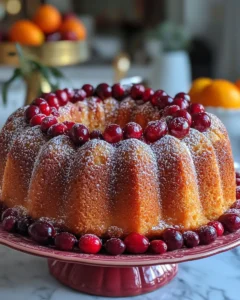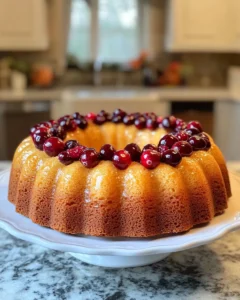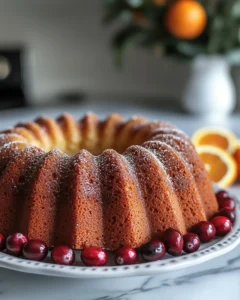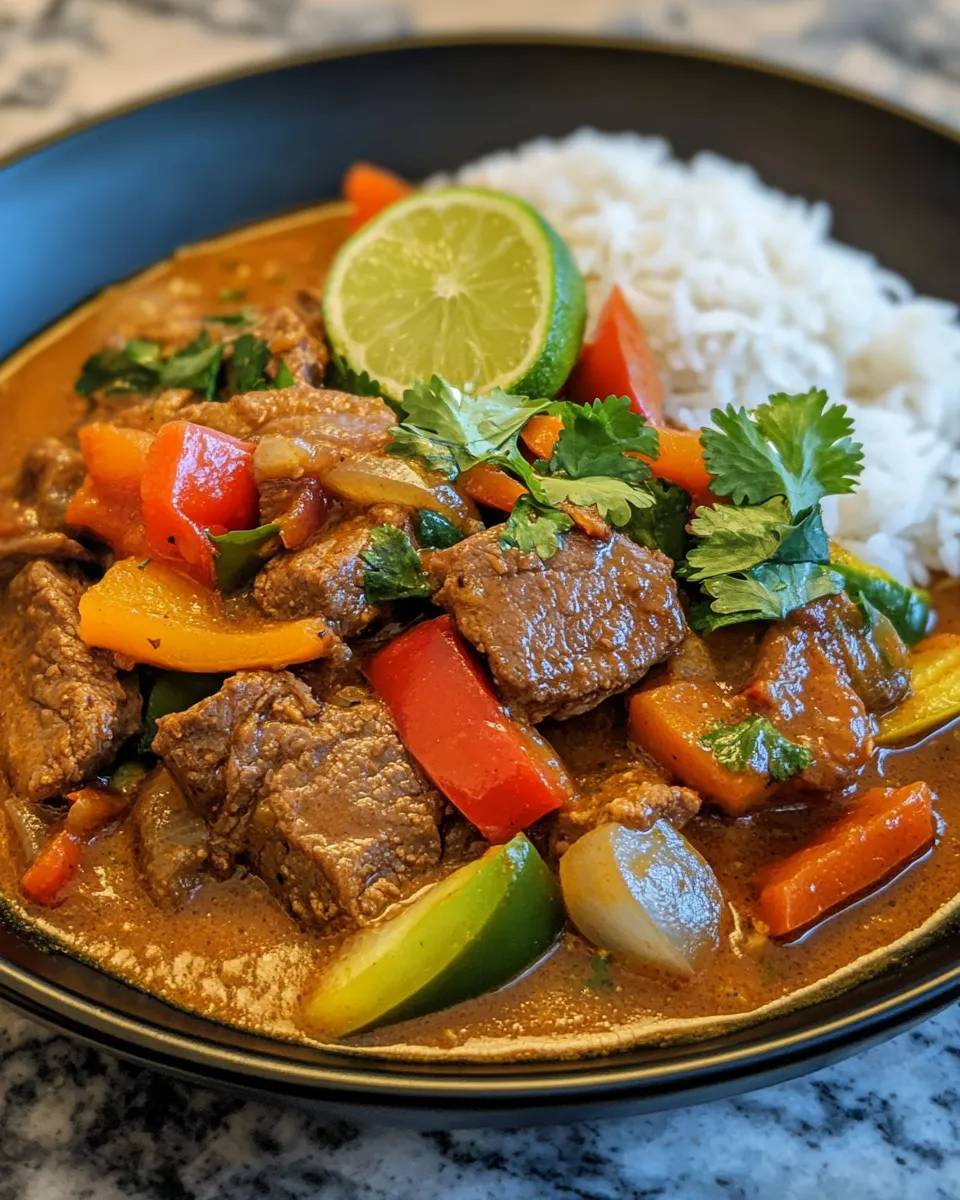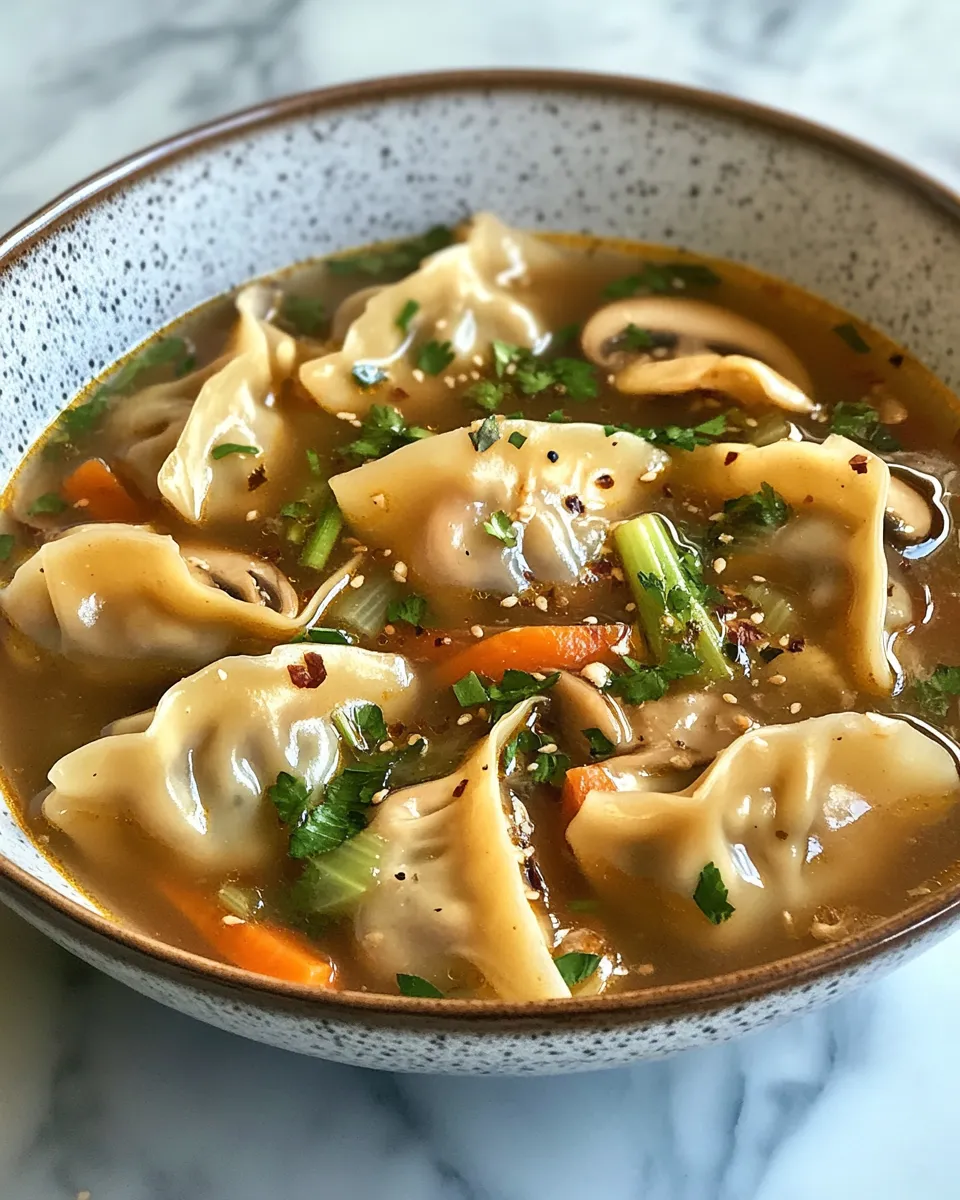There’s something truly magical about a cake that feels festive yet timeless, and this Cranberry Orange Bundt Cake is exactly that. Whether you’re preparing a holiday dessert, hosting a family gathering, or simply craving something special to brighten a cozy evening, this cake delivers in both flavor and charm. The tart burst of cranberries paired with the brightness of fresh orange creates a refreshing balance that makes each slice irresistible. It’s a recipe that feels nostalgic and celebratory at the same time, reminding us of winter holidays, family traditions, and joyful tables filled with sweet treats. If you’ve ever wanted to serve a dessert that’s both eye-catching and satisfying, this bundt cake is the perfect choice.
Why You’ll Love This Cranberry Orange Bundt Cake
- Festive Flavor Combination: Tart cranberries and sweet orange zest create a vibrant pairing that’s both refreshing and comforting.
- Beautiful Presentation: The bundt cake shape adds elegance without requiring elaborate decoration.
- Perfect for Any Occasion: Ideal for Thanksgiving, Christmas, Easter, or even a casual brunch.
- Make-Ahead Friendly: This cake stays moist and flavorful, making it perfect for preparing in advance.
- Crowd-Pleaser: Its balance of sweet and tangy appeals to both kids and adults alike.
Ingredients
For the Cake
- 3 cups all-purpose flour
- 2 teaspoons baking powder
- 1/2 teaspoon baking soda
- 1 teaspoon salt
- 1 cup unsalted butter, softened
- 2 cups granulated sugar
- 4 large eggs, room temperature
- 1 cup sour cream
- 1/2 cup fresh orange juice
- 2 tablespoons orange zest
- 2 teaspoons vanilla extract
- 2 cups fresh or frozen cranberries (if frozen, do not thaw)
- 2 tablespoons all-purpose flour (for coating cranberries)
For the Glaze
- 1 1/2 cups powdered sugar
- 3–4 tablespoons fresh orange juice
- 1 teaspoon orange zest
Directions
Preheat and Prepare the Pan
To begin, set your oven to 350°F (175°C) so it’s ready by the time your batter is mixed. The bundt pan is the star of this recipe, and preparing it well is critical. Generously grease every corner and curve of the pan with butter or nonstick spray. After greasing, dust the inside with a light coating of flour, shaking out any excess. This important step ensures your cake will release cleanly, showing off the beautiful ridges of the bundt design without sticking.
Mix Dry Ingredients
In a medium-sized mixing bowl, whisk together the flour, baking powder, baking soda, and salt. This step evenly distributes the leavening agents throughout the flour, helping the cake rise consistently during baking. Set this mixture aside—you’ll add it gradually later when combining everything into a smooth batter.
Cream Butter and Sugar
Next, place the softened butter and granulated sugar in a large mixing bowl. Using an electric mixer, beat them together for 3–4 minutes, or until the mixture becomes pale, light, and fluffy. This creaming process incorporates air into the butter, which helps create a tender crumb and adds volume to the cake. Don’t rush this step—it’s key to achieving that perfect bakery-style texture.
Add Eggs and Flavorings
Once the butter and sugar are fully creamed, add the eggs one at a time. Beating each egg in separately ensures a smooth and uniform batter. After the eggs, mix in the sour cream for richness, followed by the freshly squeezed orange juice, orange zest, and vanilla extract. These ingredients not only enhance the flavor but also add moisture, ensuring the cake bakes up soft and fragrant with citrusy notes.
Combine Wet and Dry Ingredients
Now it’s time to bring everything together. Gradually add the dry flour mixture to the wet mixture in two to three additions, mixing gently after each one. Stir only until you no longer see streaks of flour. Overmixing at this stage can lead to a dense cake, so keep the mixing light and deliberate. The batter should be thick but spreadable.
Prepare the Cranberries
Cranberries bring bright pops of tartness to the cake, but without a little preparation, they can sink to the bottom during baking. To prevent this, place the cranberries in a small bowl and toss them with 2 tablespoons of flour until they’re lightly coated. This simple trick helps suspend the berries throughout the batter so every slice gets a balanced distribution of fruit.
Fold in Cranberries
Gently fold the flour-coated cranberries into the batter using a spatula. Take care not to crush the berries, as this can streak the batter with excess juice. A gentle folding motion ensures the cranberries are evenly distributed without breaking down.
Bake the Cake
Transfer the batter into the prepared bundt pan, spreading it evenly with a spatula to fill every curve of the pan. Tap the pan lightly on the counter to release any air bubbles. Place the pan in the preheated oven and bake for 50–60 minutes. Begin checking for doneness around the 50-minute mark by inserting a toothpick into the center—if it comes out clean or with only a few crumbs, the cake is done. If the toothpick shows wet batter, continue baking in 5-minute increments.
Cool and Remove from Pan
Once baked, allow the cake to rest in the pan for 15 minutes. This cooling period helps the cake set, making it easier to release from the bundt pan. After 15 minutes, carefully invert the pan onto a wire rack. If the pan was well-prepared, the cake should release smoothly, revealing the elegant shape of the bundt design. Let the cake cool completely before glazing.
Make the Glaze
In a small bowl, combine the powdered sugar, freshly squeezed orange juice, and orange zest. Whisk until smooth and glossy. You can adjust the glaze to your preferred consistency—add more powdered sugar for a thicker glaze that clings to the cake or more orange juice for a thinner glaze that drips elegantly down the sides.
Glaze the Cake
Once the cake is completely cool, transfer it to a serving platter. Drizzle the glaze evenly over the top of the bundt, letting it cascade down the ridges for a striking presentation. The glaze not only adds extra sweetness but also enhances the citrus flavor, tying the entire dessert together. After glazing, allow the cake to sit for a few minutes so the glaze can set before slicing and serving.
Tips for Success
- Use Fresh Zest: Freshly grated orange zest brings out the best citrus flavor.
- Don’t Overmix: Overmixing can make the cake dense. Mix just until the ingredients are combined.
- Check Doneness: Every oven varies, so begin checking around the 50-minute mark.
- Room Temperature Ingredients: Butter, eggs, and sour cream at room temperature mix more smoothly and evenly.
- Grease Thoroughly: Pay extra attention to the bundt pan’s crevices to ensure easy release.
Variations
- Add Nuts: Fold in 1 cup of chopped pecans or walnuts for added crunch.
- White Chocolate Glaze: Swap the orange glaze with melted white chocolate for a decadent twist.
- Mini Bundts: Make individual bundt cakes by using a mini bundt pan—perfect for gift giving.
- Dried Cranberries: If fresh cranberries aren’t available, rehydrate dried cranberries in warm water for 10 minutes before using.
- Cranberry Swirl: Add a layer of cranberry sauce in the middle of the batter for a surprise filling.
Serving Suggestions
This Cranberry Orange Bundt Cake pairs beautifully with:
- A warm cup of coffee or tea for an afternoon treat.
- Freshly whipped cream or vanilla ice cream for an indulgent dessert.
- A brunch spread with quiche, fruit salad, and pastries.
- Holiday tables alongside other classics like pumpkin pie or gingerbread.
Storage and Make-Ahead Tips
- Room Temperature: Store the cake covered at room temperature for up to 3 days.
- Refrigeration: For longer storage, keep in an airtight container in the refrigerator for up to 5 days.
- Freezing: Wrap the cake tightly in plastic wrap and aluminum foil, then freeze for up to 2 months. Thaw overnight in the refrigerator before serving.
- Make Ahead: Bake the cake a day in advance, then glaze it just before serving for the freshest look.
Frequently Asked Questions
Can I use frozen cranberries?
Absolutely! Frozen cranberries are an excellent substitute for fresh ones, and they work seamlessly in this cake. The key is to use them straight from the freezer without thawing. Thawed cranberries tend to release too much juice, which can bleed into the batter and turn it pink or streaky. By adding them frozen, you’ll preserve their tart burst of flavor and ensure they hold their shape beautifully throughout the baking process. If you only have frozen cranberries on hand, rest assured that your cake will still bake up moist, flavorful, and just as delicious as with fresh berries.
What if I don’t have a bundt pan?
A bundt pan certainly creates a show-stopping presentation, but you don’t need one to enjoy this recipe. If you don’t own a bundt pan, you can bake the batter in two standard loaf pans or even a 9×13-inch rectangular baking dish. Keep in mind that baking times may vary depending on the type of pan you choose. Start checking for doneness a little earlier than the recipe suggests by inserting a toothpick into the center. If it comes out clean or with only a few crumbs, your cake is ready. While the classic bundt shape adds elegance, the flavor of cranberry and orange will shine through no matter which pan you use.
Can I make this cake dairy-free?
Yes, you can absolutely adapt this recipe to fit a dairy-free lifestyle. Simply replace the butter with a dairy-free substitute such as vegan butter or margarine. For the sour cream, swap in a plant-based alternative—dairy-free sour cream or even a thick non-dairy yogurt works beautifully. The texture may be slightly different, but the cake will still be moist, flavorful, and rich with citrus notes. This flexibility makes it possible for everyone at the table to enjoy a slice, even those with dietary restrictions.
How do I prevent the cake from sticking to the pan?
Nothing is more frustrating than baking a gorgeous cake only to have it stick inside the pan. To prevent this, it’s important to thoroughly grease the bundt pan with butter or a high-quality nonstick spray. After greasing, dust the entire inside with flour, ensuring you reach into every crevice of the pan. This creates a barrier that helps the cake release cleanly once baked. If you’d like extra reassurance, silicone bundt pans are also an excellent option because they naturally release baked goods with less effort. Taking a few minutes to prepare your pan properly will guarantee that your finished cake slides out effortlessly, preserving its beautiful bundt shape.
Print
Cranberry Orange Bundt Cake Recipe
- Total Time: 1 hour 15 minutes
- Yield: 12 servings 1x
Description
This Cranberry Orange Bundt Cake is a festive and flavorful dessert that combines tart cranberries with the bright citrusy notes of orange. Perfect for holidays, family gatherings, or cozy evenings, it’s a cake that looks beautiful, tastes refreshing, and feels special without being overly complicated. With its tender crumb and a sweet orange glaze, this cake is sure to impress guests and become a seasonal favorite.
Ingredients
-
3 cups all-purpose flour
-
2 teaspoons baking powder
-
1/2 teaspoon baking soda
-
1 teaspoon salt
-
1 cup unsalted butter, softened
-
2 cups granulated sugar
-
4 large eggs, room temperature
-
1 cup sour cream
-
1/2 cup fresh orange juice
-
2 tablespoons orange zest
-
2 teaspoons vanilla extract
-
2 cups fresh or frozen cranberries (do not thaw if frozen)
-
2 tablespoons all-purpose flour (for coating cranberries)
For the Glaze:
-
1 1/2 cups powdered sugar
-
3–4 tablespoons fresh orange juice
-
1 teaspoon orange zest
Instructions
-
Preheat oven to 350°F (175°C). Grease and flour a 10–12 cup bundt pan thoroughly.
-
In a medium bowl, whisk together flour, baking powder, baking soda, and salt. Set aside.
-
In a large mixing bowl, cream the butter and sugar with an electric mixer until light and fluffy, about 3–4 minutes.
-
Beat in the eggs one at a time. Add sour cream, orange juice, orange zest, and vanilla extract. Mix until combined.
-
Gradually add the dry ingredients to the wet mixture, mixing just until no streaks remain. Do not overmix.
-
Toss cranberries with 2 tablespoons flour in a small bowl. Fold them gently into the batter.
-
Transfer the batter into the prepared bundt pan, spreading evenly. Bake for 50–60 minutes, or until a toothpick inserted in the center comes out clean.
-
Let the cake cool in the pan for 15 minutes before inverting onto a wire rack. Cool completely.
-
For the glaze, whisk together powdered sugar, orange juice, and zest until smooth. Adjust consistency as needed.
-
Drizzle glaze over the cooled cake and let it set before slicing.
Notes
- Prep Time: 20 minutes
- Cook Time: 55 minutes


